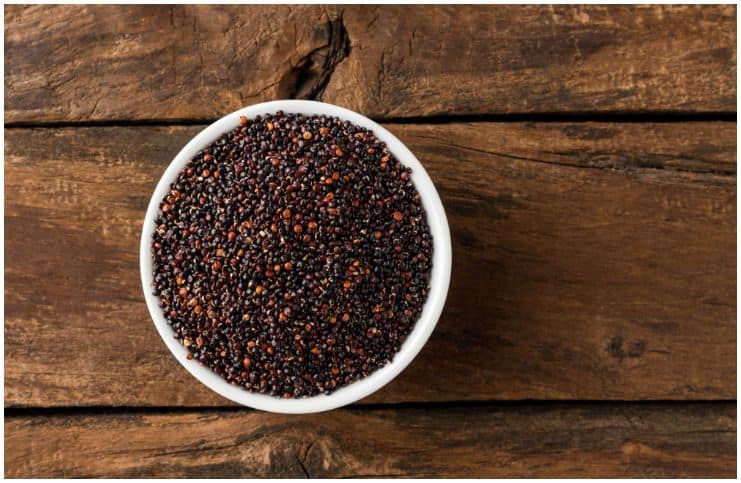Bulgur
It is a staple of Middle Eastern cuisine, commonly used to make pilafs and tabbouleh. To make this food, whole-wheat kernels are simmered and then baked.
Furthermore, it is an amazing great replacement for white rice since it has more nutrients and dietary fiber as well as it is a low glycemic index food. Due to the fact that it remains high in minerals and protein, it is an ideal foundation for many meals and a substitute for higher protein sources, like legumes or meat.
Nutrition Facts
It is an excellent source of protein, dietary fiber, iron, thiamin, vitamin B-6, niacin, vitamin K, folate, pantothenic acid, magnesium, manganese, calcium, phosphorus, and selenium.
Health Benefits
Enhances Sports Performance
It is a good source of the essential mineral – magnesium, which works as a co-factor for more than 300 enzymes, some of which are involved in the human body’s mechanism of insulin production and the use of fats.
In addition, magnesium helps move sugar into the muscles during physical exercise as well as it helps to prevent lactic acid from building up. Signs and symptoms of deficiency of this mineral include – cardiovascular disease, muscle spasms, hypertension, type 2 diabetes mellitus, headaches migraines, and osteoporosis.
Iron Anemia Prevention
It is a source of iron, which is an essential mineral involved in making red blood cells and the synthesis of protein, certain hormones, and neurotransmitters. Also, it prevents iron anemia, the main dietary deficiency worldwide.
The following are also possible signs and symptoms of this type of anemia – the need of eating non-nutritive substances, like – clay, dirt, and ice (a condition known as pica), decreased immune function, always feeling cold, irritability or moodiness, poor concentration, fatigue, sleepiness, or a decreased physical performance.
Heart Health
Men and women who consumed large quantities of betaine, a metabolic present in this food, have lower concentrations of homocysteine, a non-protein α-amino acid, that has been related to heart disease, type 2 diabetes, Alzheimer’s disease, and osteoporosis, according to a recent study.
More importantly, individuals who regularly consume this food, have a far lower risk of developing hypertension, as per a study which was done by scientists at the American Heart Association.
Prevents Constipation
The high dietary fiber content of these foods will help food move swiftly through the human body, which will prevent constipation and avoid developing piles. Also, the insoluble fiber it contains promotes faster elimination of waste, which also prevents the formation of an environment which promotes the development of carcinogens.
Side Effects
There are no side effects consuming this food, except for people with gluten intolerance.
Quinoa
It is the edible seed of the plant that belongs to the genus Chenopodium in the family Amaranthaceae. Grown in Chile, Peru, and Bolivia for millennia, it formed the staple diet of the Incas and their descendants. It was known to the Incas as “the mother of all grains” because it was first cultivated over 5,000 years ago.
In addition, it is known as an “ancient grain” and it is technically not a cereal grain or grain, but a seed referred to as a pseudo-grain.
Nutrition Facts
It is high in protein, gluten-free, and one of the few plant foods which contains all nine essential amino acids. Compared to brown and white rice, it has more protein and fewer carbs. It is also a good source of phosphorus, manganese, copper, iron, thiamine, riboflavin, zinc, potassium, vitamin B6, vitamin E, and selenium.
Health Benefits
Reduces LDL CHolesterol
Dietary fiber may help you to lose weight due to the fact it takes a longer time to chew than does other foods, plus, it increases satiety and is less energy-dense. Moreover, fiber reduces LDL and total cholesterol as well as glucose levels, which makes it ideal for patients with type 2 diabetes.
Bone Health
The amount of calcium found in this pseudo-grain is similar to that of dairy products, however, it has been pointed out that people who are intolerant of dairy products (more than fifty percent of people worldwide) can eat it.
Calcium is also involved in the maintenance and growth of bones. According to research, calcium, along with vitamin D (also known as the sunshine vitamin), may have benefits beyond bone health, maybe even protecting against type 2 diabetes mellitus, cancer, and hypertension.
Antioxidant Properties
Free radicals steal electrons from other molecules (proteins, fats, cell membranes, and even from the deoxyribonucleic acid), altering the main structure of the affected molecule. This pseudo-grain is very high in antioxidants, substances that neutralize free radical damage.
Skin & Hair
Vitamin B2, also known as riboflavin, is part of the family of B vitamins and is helping the human body with a variety of functions, particularly in maintaining proper collagen levels, a protein that makes up healthy hair and skin.
Side Effects
There are no known side effects.
Bulgur versus Quinoa – Which is Healthier?
Both these foods are healthy and nutritious, however, quinoa has a better nutritional profile, especially due to its magnesium, phosphorus, folate, thiamin, and zinc content.
Image credit – Shutterstock
READ THIS NEXT: Pomelo vs Grapefruit
